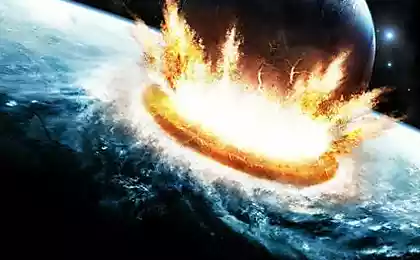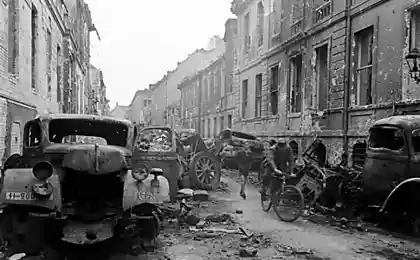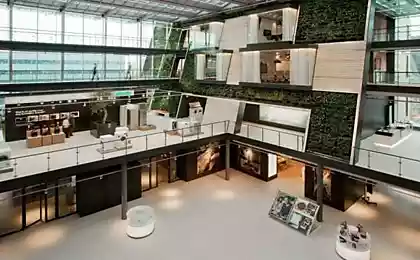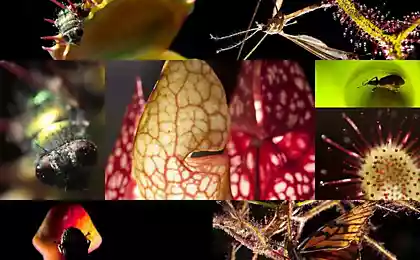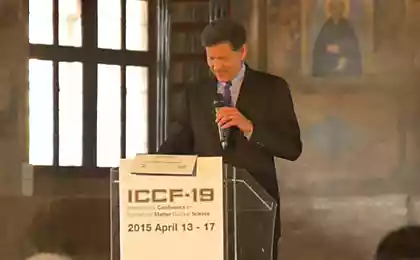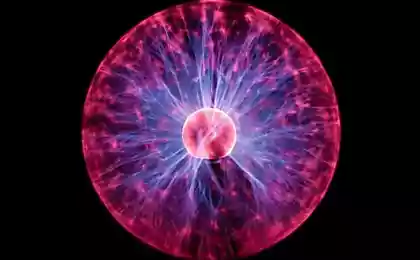445
Ecoarchitecture William McDonough offers to end the war on carbon
The first way to end the war with carbon, according to the concept of the co-author of the book "Cradle to Cradle: Remaking the Way We Make Things" is to stop calling it a war. Architect and designer William McDonough, who recently announced plans Silicon Valley of Agriculture in Denmark, offered a "new language" for the carbon element, which can be used "safely, efficiently and profitably." "Climate change is the result of failures in the carbon cycle caused by ourselves: it is the lack of design," notes William McDonough in a press release. — "Anthropogenic greenhouse gases in the atmosphere making carbon stuff appearing in the wrong place at the wrong doses at the wrong time. We have made carbon a toxin, like lead in our drinking water. In the right place, the carbon is a resource and tool." In the same way as the movement of a Cradle-to-Cradle taught the initiators of sustainable development to rethink the usual way to reduce or even destruction of waste, "new language" of carbon developed by William McDonough to help us to model human design "life-giving carbon cycle and to realize the flow closed loop uglerodnych nutrients" as an asset, instead of demonize.

Three new categories replace the carbon negative terms such as "zero carbon", "low carbon" or "carbon negative" to something more positive. Living carbon is organic carbon that participates in biological cycles and providing fresh food, healthy forests and fertile soil; that we want to develop and multivariate. Durable carbon enclosed in a stable solids, such as coal and limestone, or in polymers that can be recycled and re-used; the spectrum from recycled fibers such as paper and fabrics to the production of infrastructure elements that can exist for several generations, and then re-used. Fugitive carbon is undesirable and can be toxic; includes carbon dioxide emitted into the atmosphere by burning fossil fuels, energy production from primary processing waste ("waste to energy"), leakage of methane, deforestation and as a result of industrial agriculture and urban development.
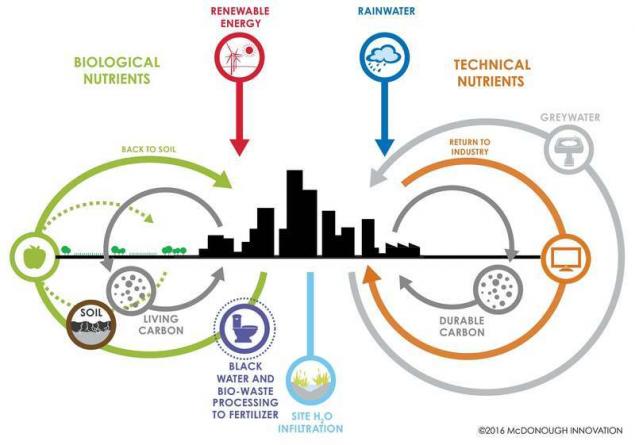
William McDonough defines a new strategy for the management of carbon and to combat climate change: Carbon positive: actions that turn atmospheric carbon into forms that improve the nutrition of the soil, or long-term forms, such as polymers and solid units; also the recycling of carbon in the nutrients of organic materials, food waste, compostable polymers and sewers; Carbon neutral: actions transformerait or support the durable carbon associated with Land forms and cycles from generation to generation; or renewable energy sources such as solar, wind and hydropower, which do not emit carbon; Carbon-negative: actions that pollute land, water and atmosphere of the various forms of carbon, for example, the presence of CO2 and methane in the atmosphere or plastics in the ocean. William McDonough also developed a clear concept of this "new language" of carbon. Carbon-positive city, in his view, integrates agriculture, regenerative methods of land management and urban design in a regional and international scale. Provides a holistic synergistic system for the conversion of fugitive carbon in the solid carbon takii as plastics and building materials, as well as in live carbon, i.e., healthy soils, gardens and landscapes.
The infrastructure of the city adapts to a new idea: sewage treatment plants become "factories of fertilizer", while the integrated agricultural systems are referred to as "solar gardens" that provide clean energy, food, water and jobs.
P. S. And remember, only by changing their consumption — together we change the world! ©
Source: www.energy-fresh.ru/ekosfera/ecology/?id=13888

Three new categories replace the carbon negative terms such as "zero carbon", "low carbon" or "carbon negative" to something more positive. Living carbon is organic carbon that participates in biological cycles and providing fresh food, healthy forests and fertile soil; that we want to develop and multivariate. Durable carbon enclosed in a stable solids, such as coal and limestone, or in polymers that can be recycled and re-used; the spectrum from recycled fibers such as paper and fabrics to the production of infrastructure elements that can exist for several generations, and then re-used. Fugitive carbon is undesirable and can be toxic; includes carbon dioxide emitted into the atmosphere by burning fossil fuels, energy production from primary processing waste ("waste to energy"), leakage of methane, deforestation and as a result of industrial agriculture and urban development.

William McDonough defines a new strategy for the management of carbon and to combat climate change: Carbon positive: actions that turn atmospheric carbon into forms that improve the nutrition of the soil, or long-term forms, such as polymers and solid units; also the recycling of carbon in the nutrients of organic materials, food waste, compostable polymers and sewers; Carbon neutral: actions transformerait or support the durable carbon associated with Land forms and cycles from generation to generation; or renewable energy sources such as solar, wind and hydropower, which do not emit carbon; Carbon-negative: actions that pollute land, water and atmosphere of the various forms of carbon, for example, the presence of CO2 and methane in the atmosphere or plastics in the ocean. William McDonough also developed a clear concept of this "new language" of carbon. Carbon-positive city, in his view, integrates agriculture, regenerative methods of land management and urban design in a regional and international scale. Provides a holistic synergistic system for the conversion of fugitive carbon in the solid carbon takii as plastics and building materials, as well as in live carbon, i.e., healthy soils, gardens and landscapes.
The infrastructure of the city adapts to a new idea: sewage treatment plants become "factories of fertilizer", while the integrated agricultural systems are referred to as "solar gardens" that provide clean energy, food, water and jobs.
P. S. And remember, only by changing their consumption — together we change the world! ©
Source: www.energy-fresh.ru/ekosfera/ecology/?id=13888
